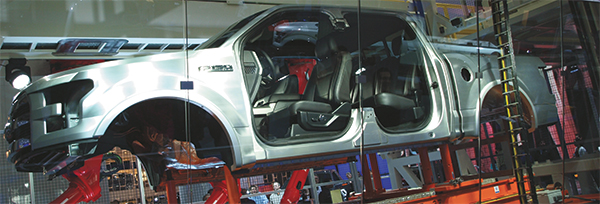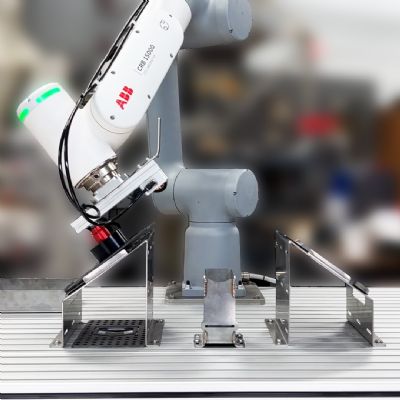Taking Transfer to a Whole New Level
Some in the industry—the “top stampers” as Stirrett calls them—are taking transfer to a new level by engineering dies that combine the characteristics of a progressive die (coil fed) and a transfer die. Using this prog-to-transfer process allows the stamper to optimally nest the blanks in the coil and then use in-die automation to manipulate the separated blanks—separate and rotate—for the transfer process.
 “This optimizes material utilization to levels never seen before,” says Stirrett. “We first saw the process start to take hold 3 or 4 yr. ago and it’s really taken off in the last year or two.”
“This optimizes material utilization to levels never seen before,” says Stirrett. “We first saw the process start to take hold 3 or 4 yr. ago and it’s really taken off in the last year or two.”
For an up-close perspective on the prog-to-transfer process, Stirrett hooked us up with fellow Canadian company Egar Tool and Die, Cambridge, Ontario, who he says helped to pioneer the concept back in 2010. Egar is part die shop part stamper, with four production presses from 400 to 1200 ton. Its two largest presses—a 1000-metric-ton PTC (84 by 180 in.) and a 1200-ton Blow (80 by 180 in.)—feature three-axis Linear Transfer servo-based automation systems. They also include 72-in. coil-feed lines accepting coils to 50,000 lb.
Egar produces some 15 million stamped parts/yr. Of its 150 part numbers in production (95 percent for automotive customers), one-third are stamped in prog-to-transfer dies. One die designer at Egar is responsible for designing 80 percent of those dies: Colin Kools.
“Coil-fed transfer allows us to squeeze every bit of material out of the coil as possible,” says Kools. “But the dies are more expensive than traditional dies because once we blank we have to separate and rotate the blanks using mechanical or pneumatic devices. We separate the blanks and move them outward, closer to the transfer rails, so that the transfer arms can be shorter—this makes for a more rigid process so we can run more quickly. We also rotate the parts to position them optimally for engagement by the transfer tooling, and for optimum design of each die station.
“We use a lot of sensors on the dies and the transfer tooling,” Kools adds. “That said, in most cases we can justify the added cost to the dies within a year or two of production due to the material savings.”
Speaking of Material Savings
Egar stamps primarily frame and undercarriage parts; its sweet spot for material thickness (primarily high-strength low-alloy) is 2.5-3.5 mm. Kools notes that its prog-to-transfer dies run at 18-23 strokes/min.In one example provided by Kools, stamping a clevis plate from 3.75-mm HSLA steel, converting the part from a progressive die to a prog-to-transfer die enabled a reduction in blank size from 8 by 31 in. down to 9.4 by 19.44 in. (a 26 percent reduction), and a per-piece weight reduction from 4.98 lb. to 3.67 lb. The die features a pneumatic shuttle mechanism (with a die—driven bypass cam) and a servo-bar-mounted rotator to reposition the blank after leaving the coil.
“This technology must continue to grow in use,” Kools stresses. “Customers are demanding less-expensive parts from more expensive materials, and the prog-to-transfer die clearly has become part of the solution. There’s so much material being wasted in processes where the die design does not contribute to optimizing material utilization. We’re addressing that in a big .” MFView Glossary of Metalforming Terms
See also: Blow Press Limited, Linear Transfer Automation Inc., PTC Inc.
Technologies: Coil and Sheet Handling, Materials, Pressroom Automation









 Video
Video